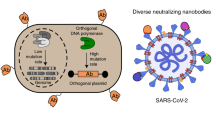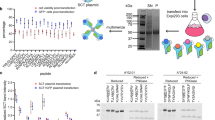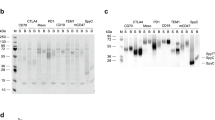Abstract
Here we have constructed a single-chain T-cell receptor (scTCR) scaffold with high stability and soluble expression efficiency by directed evolution and yeast surface display. We evolved scTCRs in parallel for either enhanced resistance to thermal denaturation at 46°C, or improved intracellular processing at 37°C, with essentially equivalent results. This indicates that the efficiency of the consecutive kinetic processes of membrane translocation, protein folding, quality control, and vesicular transport can be well predicted by the single thermodynamic parameter of thermal stability. Selected mutations were recombined to create an scTCR scaffold that was stable for over an hour at 65°C, had solubility of over 4 mg ml−1, and shake-flask expression levels of 7.5 mg l−1, while retaining specific ligand binding to peptide–major histocompatibility complexes (pMHCs) and bacterial superantigen. These properties are comparable to those for stable single-chain antibodies, but are markedly improved over existing scTCR constructs. Availability of this scaffold allows engineering of high-affinity soluble scTCRs as antigen-specific antagonists of cell-mediated immunity. Moreover, yeast displaying the scTCR formed specific conjugates with antigen-presenting cells (APCs), which could allow development of novel cell-to-cell selection strategies for evolving scTCRs with improved binding to various pMHC ligands in situ.
This is a preview of subscription content, access via your institution
Access options
Subscribe to this journal
Receive 12 print issues and online access
$209.00 per year
only $17.42 per issue
Buy this article
- Purchase on Springer Link
- Instant access to full article PDF
Prices may be subject to local taxes which are calculated during checkout





Similar content being viewed by others
References
Soo Hoo, W.F. et al. Characterization of a single-chain T-cell receptor expressed in Escherichia coli. Proc. Natl. Acad. Sci. USA 89, 4759–4763 (1992).
Novotny, J. et al. A soluble single-chain T-cell receptor endowed with antigen-combining properties. Proc. Natl. Acad. Sci. USA 88, 8646–8650 (1991).
Schodin, B.A., Schlueter, C.J. & Kranz, D.M. Binding properties and solubility of single-chain T cell receptors expressed in E. coli. Mol. Immunol. 33, 819–829 (1996).
Necker, A. et al. Monoclonal antibodies raised against engineered soluble mouse T cell receptors and specific for Valpha8-, Vbeta2- or Vbeta10-bearing T cells. Eur. J. Immunol. 21, 3035–3040 (1991).
Eilat, D., Kikuchi, G.E., Coligan, J.E. & Shevach, E.M. Secretion of a soluble, chimeric gamma-delta T-cell receptor-immunoglobulin heterodimer. Proc. Natl. Acad. Sci. USA. 89, 6871–6875 (1992).
Weidanz, J.A., Card, K.F., Edwards, A., Perlstein, E. & Wong, H.C. Display of functional alphabeta single-chain T-cell receptor molecules on the surface of bacteriophage. J Immunol. Meth. 221, 59–76 (1998).
Shusta, E.V., Kieke, M.C., Parke, E., Kranz, D.M. & Wittrup, K.D. Yeast polypeptide fusion surface display levels predict thermal stability and soluble secretion efficiency. J. Mol. Biol. 292, 949–956 (1999).
Shimba, N. et al. Comparative thermodynamic analyses of the Fv, Fab* and Fab fragments of anti-dansyl mouse monoclonal antibody. FEBS Lett. 360, 247–250 (1995).
Webber, K.O., Reiter, Y., Brinkmann, U., Kreitman, R. & Pastan, I. Preparation and characterization of a disulfide-stabilized Fv fragment of the anti-Tac antibody: comparison with its single-chain analog. Mol Immunol. 32, 249–258 (1995).
Young, N.M., MacKenzie, C.R., Narang, S.A., Oomen, R.P. & Baenziger, J.E. Thermal stabilization of a single-chain Fv antibody fragment by introduction of a disulphide bond. FEBS Lett. 377, 135–139 (1995).
Wülfing, C. & Plückthun, A. Correctly folded T-cell receptor fragments in the periplasm of Escherichia coli, influence of folding catalysts. J. Mol. Biol. 242, 655–669 (1994).
Engel, I., Ottenhoff, T.H. & Klausner, R.D. High-efficiency expression and solubilization of functional T cell antigen receptor heterodimers. Science 256, 1318–1321 (1992).
Boder, E.T. & Wittrup, K.D. Yeast surface display for screening combinatorial polypeptide libraries. Nat. Biotechnol. 15, 553–557 (1997).
Kieke, M.C., Cho, B.K., Boder, E.T., Kranz, D.M. & Wittrup, K.D. Isolation of anti-T cell receptor scFv mutants by yeast surface display. Protein Eng. 10, 1303–1310 (1997).
Kieke, M.C. et al. Selection of functional T cell receptor mutants from a yeast surface-display library. Proc. Natl. Acad. Sci. USA 96, 5651–5656 (1999).
Manning, T.C. et al. Alanine scanning mutagenesis of an alphabeta T cell receptor: mapping the energy of antigen recognition. Immunity 8, 413–425 (1998).
Clements, J.M., Catlin, G.H., Price, M.J. & Edwards, R.M. Secretion of human epidermal growth factor from Saccharomyces cerevisiae using synthetic leader sequences. Gene 106, 267–271 (1991).
Parekh, R.N., Shaw, M.R. & Wittrup, K.D. An integrating vector for tunable high copy stable integration into the dispersed Ty δ sites of Saccharomyces cerevisiae. Biotechnol. Prog. 12, 16–21 (1996).
Shusta, E.V., Raines, R.T., Plückthun, A. & Wittrup, K.D. Increasing the secretory capacity of Saccharomyces cerevisiae for production of single-chain antibody fragments. Nat. Biotechnol. 16, 773–777 (1998).
Redding, K., Holcomb, C. & Fuller, R.S. Immunolocalization of Kex2 protease identifies a putative late Golgi compartment in the yeast Saccharomyces cerevisiae. J. Cell Biol. 113, 527–38 (1991).
Suzuki, C.K., Bonifacino, J.S., Lin, A.Y., Davis, M.M. & Klausner, R.D. Regulating the retention of T-cell receptor alpha chain variants within the endoplasmic reticulum: Ca2+ dependent association with BiP. J. Cell Biol. 114, 189–205 (1991).
Van Leeuwen, J.E.M. & Kearse, K.P. The related molecular chaperones calnexin and calreticulin differentially associate with nascent T cell antigen receptor proteins within the endoplasmic reticulum. J. Biol. Chem. 41, 25345–25349 (1996).
Altman, J.D. et al. Phenotypic analysis of antigen-specific T lymphocytes. Science 274, 94–96 (1996). (Published erratum appears in Science 280, 1821, 1998.)
Sykulev, Y. et al. High-affinity reactions between antigen-specific T-cell receptors and peptides associated with allogeneic and syngeneic major histocompatibility complex class I proteins. Proc Natl Acad Sci USA 91, 11487–11491 (1994).
Lebowitz, M.S. et al. Soluble, high-affinity dimers of T-cell receptors and class II major histocompatibility complexes: biochemical probes for analysis and modulation of immune responses. Cell Immunol. 192, 175–184 (1999).
Reddehase, M.J., Rothbard, J.B. & Koszinowski, U.H. A pentapeptide as minimal antigenic determinant for MHC class I- restricted T lymphocytes. Nature 337, 651–653 (1989).
Udaka, K., Wiesmuller, K.H., Kienle, S., Jung, G. & Walden, P. Self-MHC-restricted peptides recognized by an alloreactive T lymphocyte clone. J. Immunol. 157, 670–678 (1996).
Fields, B.A. et al. Crystal structure of a T-cell receptor beta-chain complexed with a superantigen (see comments). Nature 384, 188–192 (1996).
Holler, P.D. et al. In vitro evolution of a T Cell receptor with high affinity for peptide/MHC. Proc. Natl. Acad. Sci. USA 97, 5387–5392 (2000).
Nieba, L., Honegger, A., Krebber, C. & Plückthun, A. Disrupting the hydrophobic patches at the antibody variable/constant domain interface: improved in vivo folding and physical characterization of an engineered scFv fragment. Prot. Eng. 10, 435–444 (1997).
Plaksin, D., Polakova, K., McPhie, P. & Margulies, D.H. A three-domain T cell receptor is biologically active and specifically stains cell surface MHC/peptide complexes. J. Immunol. 158, 2218–2227 (1997).
Chung, S., Wucherpfennig, K.W., Friedman, S.M., Hafler, D.A. & Strominger, J.L. Functional three-domain single-chain T-cell receptors. Proc. Natl. Acad. Sci. USA 91, 12654–12658 (1994)..
Kranz, D.M., Tonegawa, S. & Eisen, H.N. Attachment of an anti-receptor antibody to non-target cells renders them susceptible to lysis by a clone of cytotoxic T lymphocytes. Proc. Natl. Acad. Sci. USA 81, 7922–7926 (1984).
Gietz, R.D. & Schiestl, R.H. Transforming yeast with DNA. Meth. Mol. Cell. Biol. 5, 255–269 (1996).
Boder, E.T. & Wittrup, K.D. Optimal screening of surface-displayed polypeptide libraries. Biotechnol. Prog. 14, 55–62 (1998).
Robinson, A.S., Bockhaus, J.A., Voegler, A.C. & Wittrup, K.D. Reduction of BiP levels decreases heterologous protein secretion in Saccharomyces cerevisiae. J. Biol. Chem. 271, 10017–10022 (1996).
Laboissiere, M.C.A., Sturley, S.L. & Raines, R.T. The essential function of protein disulfide isomerase is to unscramble non-native disulfide bonds. J. Biol. Chem. 47, 28006–28009 (1995).
Tachibana, C. & Stevens, T.H. The yeast EUG1 gene encodes an endoplasmic reticulum protein that is functionally related to protein disulfide isomerase. Mol. Cell Biol. 12, 4601–4611 (1992).
Scopes, R.K. Measurement of protein by spectrophotometry at 205 nm. Anal. Biochem. 59, 277–282 (1974).
Alexander, J., Payne, J.A., Murray, R., Frelinger, J.A. & Cresswell, P. Differential transport requirements of HLA and H-2 class I glycoproteins. Immunogenetics 29, 380–388 (1989).
Garcia, K.C. et al. An alphabeta T cell receptor structure at 2.5 A and its orientation in the TCR-MHC complex. Science 274, 209–219 (1996).
Acknowledgements
Thanks to Roy Mariuzza and Peter Andersen for the superantigen mutant SEC3/1A4, Sean O'Herrin and Jeff Bluestone for QL9/Ld dimers, and Steve Jameson and Mark Daniels for SIYR/Kb tetramers. This work was funded by NIH GM55757 and NSF BES 95-31407. We would like to acknowledge Dr. Michael Glaser and Jonah Chan for their assistance in performing the fluorescence microscopy, and Gary Durack of the University of Illinois Flow Cytometry Facility for his assistance. Also, special thanks to Dr. Marti Ware for her rosette assay expertise.
Author information
Authors and Affiliations
Corresponding authors
Rights and permissions
About this article
Cite this article
Shusta, E., Holler, P., Kieke, M. et al. Directed evolution of a stable scaffold for T-cell receptor engineering. Nat Biotechnol 18, 754–759 (2000). https://doi.org/10.1038/77325
Received:
Accepted:
Issue Date:
DOI: https://doi.org/10.1038/77325
This article is cited by
-
“Redirecting an anti-IL-1β antibody to bind a new, unrelated and computationally predicted epitope on hIL-17A”
Communications Biology (2023)
-
Rapid screening of TCR-pMHC interactions by the YAMTAD system
Cell Discovery (2022)



